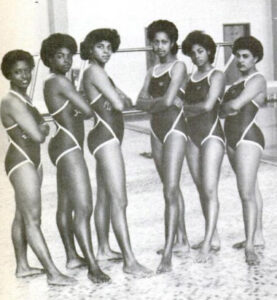
Historically Black colleges and universities aquatics programs have gradually deteriorated one-by-one over the last few decades. Due to a lack of support from the college and university administration to limited or depleted funding, HBCU aquatics was not able to sustain these very important programs.
HBCUs have a history of initiating positive change for Black communities and should be leaders in exposing aquatic opportunities to save lives, provide education, and support economic growth.
At several HBCUs, there are swimming pools that are not utilized to their fullest capacity which means students and staff are missing opportunities to learn life-saving skills that can be passed down through generations.
“Due to the change of hands in administration and lack of support, I quit coaching swimming,” said former Florida A&M University’s Swim Coach and Director of`Aquatics Center, Jorge L. Olaves.
FAMU’s backyard sits a clean saltwater 25-meter pool, which is half the size of an Olympic sized pool. This is formerly the hub for some of the best swimmers in the nation.In 1964, the swimming pool was an added feature to the university and attracted many students and faculty. By the 1980s, FAMU’s swim team had about 25 swimmers which are enough to make 6 relays, 4 persons per relay, and an alternate.
By 2002, FAMU’s swimming team was the reigning HBCU swimming champions in their division. Three years later, the university was seeking donations for the men’s and women’s swimming and diving team. The program needed almost a quarter of a million dollars for it to remain active.Although the program could not receive the support and funding it needed to continue, FAMU’s Aquatics program has opened many career opportunities especially for some of the former swimmers of the team.
Gia Wright, North Carolina A&T University’s former women’s swim team coach, said “Administration at the university was hesitant to the funding issues which caused us to lose the swimming program at A&T.”
Wright also mentioned that the swim team and other aquatics staff created a petition to keep the swimming program active. Nearly one thousand students signed the petition in support of keeping the program, but the administration still decided to disband the swim team.
In 2016, North Carolina A&T University’s women’s swim team dissolved, which left Howard University the only last standing HBCU NCAA Division I swim program.
“Budgetary issues and recruiting swimmers who mirrored the academic morale of the university and also the skill set that is needed has been our biggest challenges,” says Nicholas Askew, Howard University’s Swimming and Diving Team Coach.
Howard University is in a unique space. Since the program is the last of its kind, Askew mentions the amount of pressure that comes with it. He also mentions that the importance of Black representation in aquatics will show Black children that there are great career opportunities within aquatics.
Additionally, as HBCUs struggle with funding, using swim facilities to their maximum capacity can provide income opportunities through programming for competition, water safety lessons and recreational enjoyment.
HBCUs are the exact or ideal community that should discuss the missing swimming programs and the importance of learning how to swim within the Black community, however it seems like the administration at these HBCUs did not find the need to continue to support these aquatic programs at their colleges and universities.
In most cases, without administrative support, programs will not last that much longer.